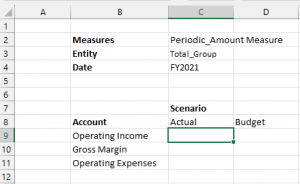Difference between revisions of "Freeform Report"
| Line 6: | Line 6: | ||
===From a grid=== | ===From a grid=== | ||
The recommended way to create a Freeform report is to convert an existing grid from the right click menu: | The recommended way to create a Freeform report is to convert an existing grid from the right click menu: | ||
| + | |||
[[File:Freeform Picture1.png]] | [[File:Freeform Picture1.png]] | ||
| Line 11: | Line 12: | ||
[[File:Freeform Picture3.png]] | [[File:Freeform Picture3.png]] | ||
| + | |||
| + | ===From Excel cells=== | ||
| + | A Freeform report can also be directly inserted from the Excel sheet by letting FluenceXL analyse the surrounding ranges of any cell located in the projected data area. | ||
| + | |||
| + | [[File:Freeform Picture4.png|300px]] | ||
Revision as of 11:33, 4 September 2023
From version 2308.1 FluenceXL supports Freeform reports.
A Freeform report is an hybrid query object that combines the flexibility of cell based reporting (similarly to FluenceXl formulas) with the performance of grids. It is natively available for any type of dimensional data source as well as for relational ones, using a Pivot View.
Inserting a Freeform report
From a grid
The recommended way to create a Freeform report is to convert an existing grid from the right click menu:
From Excel cells
A Freeform report can also be directly inserted from the Excel sheet by letting FluenceXL analyse the surrounding ranges of any cell located in the projected data area.



